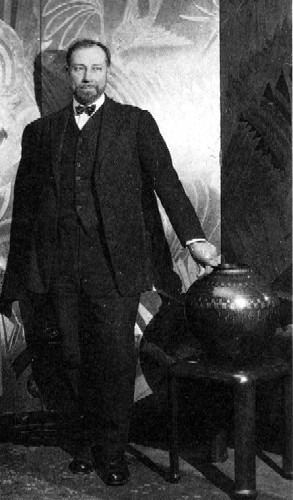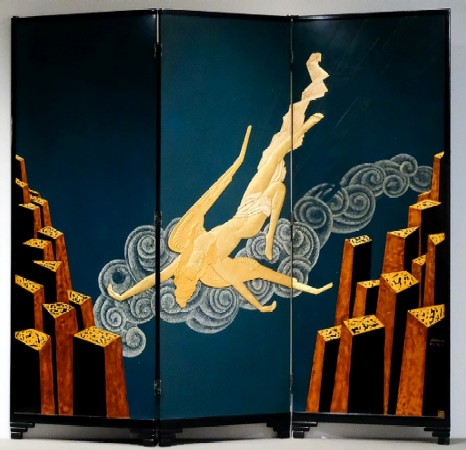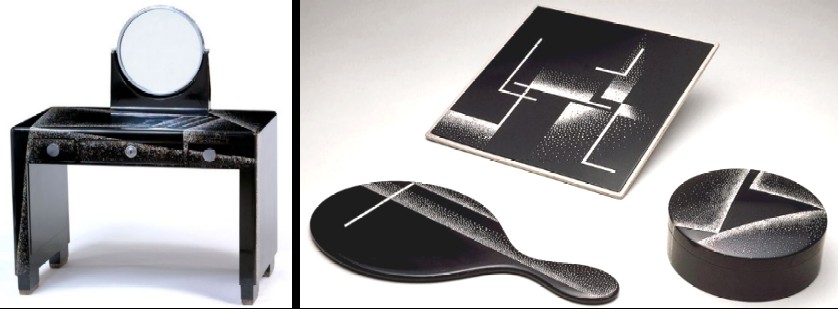
Jean Dunand (1877–1942)
Jean Dunand was a Swiss born artist and interior designer who was active during the

Jean Dunand, Pavillon de la Mode at the Exposition
Internationale des Arts Decoratifs et Industriels
Modernes, Paris, 1925
Art Deco and Streamline Modern periods. One of the hallmarks of his design style involved the use of Asian lacquers, a material he specifically sought to learn about and then continued to develop throughout his career. It was he who is most responsible for bringing shiny lacquering to the French Art Deco scene.
Dunand began formal art training at the École des Arts Industriels in Geneva in 1877. finishing with a degree in sculpture and design in 1896. He moved to Paris in 1897 to continue his training with Jean Dampt in his workshop. Here he produced metal decorations for interiors which changed his focus from creating artistic metal sculptures to interior design.
After leaving Dampt's employ, Dunand established his own workshop in Paris in 1904. There he worked with a a variety of materials, including steel, copper, pewter and silver. In 1905, he began focusing on dinanderie - decorative objects made of brass, copper and bronze. Displaying his work at a variety exhibitions in Paris and Geneva gave his shop exposure in the decorative design field. As his renown grown grew, he expanded his workshop. By 1924, his had nearly 60 employees producing a variety of objects including screens furniture sand wall panels. IA 1935 floor plan of his shop included a show room, office, several lacquer studios and areas for designing, model-making, metalworking, cabinetmaking, casting, and sculpture. His workshop remained at same location until his death in 1942.
Lacquering was central to his design style. His interest began early in his career after noticing that lacquered Japanese metal items resisted corrosion better than other metal items. Wanting to use the technique on his own metal designs he consulted with several Paris-based specialists only to discover that they didn't really understand the technique. Eager to fully learn the skill of lacquering, he reached out to Seizo Sugawara, a Japanese artist and lacquerer who had relocated to Paris from Japan in 1906. Sagawara was interested in dinanderie, so the two agreed to teach each other their trades.
Sugawara gave Dunand thirteen lessons in the art of lacquering in 1912. Jean kept notes describing the preparation, tools, materials, procedures and decorative techniques of the traditional Japanese lacquering techniques. The lacquer (urushi in Japanese) is derived from the sap obtained from the bark of Rhus vernicifera trees in Japan, China and Korea. Dunand's notes mention both sessimé - an evenly flowing, purified lacquer - and schuaye - a lacquer containing oil, which Dunand writes was used for 'ordinary and colored lacquerware'.

Lacquered Wood Screens, Pianissimo and Fortissimo, With Eggshell and
Mother-of-Pearl,
Gold, For a Music Room, Séraphin Soudbinine,Sculptor,
Jean Dunand, Lacquerer,
1925-6, The MET
Shown is Pianissimo. Mouse over the image to see the other screen Fortissimo.
He explained that black lacquer (louero) is a high quality type, obtained through a reaction between sessimé lacquer and iron filings in vinegar. Colored lacquers were made using a variety of pigments such as vermilion (schu), iron-oxide (red - benigara), cadmium and chrome yellows and Prussian blue. Mixing those colored lacquers also produced green and brown.
Dunand didn't actually start creating lacquered furniture until 1921, although he no doubt used them on his metal work such as the red and black metal pot seen below. He used and even created various lacquering methods in his designs. Some of his pieces featured the laque arrachée technique which involved lifting black lacquer with a flat wooden spatula to create an uneven surface then covering it with a silver-gray lacquer with white and yellow pigments and aluminum filings. When polished, the removed silver lacquer revealed the black lacquer beneath it in the uneven raised areas. (See the image 'Tiger on the Prowl' below.) A variety of the lacquer colors can be seen in the image 'Return of the Hunters' below.
A lacquering technique which Dunand invented involved mixing crushed eggshell fragments in a wet lacquered surface. When placed convex side up, they appeared primarily white with darker lacquer around the edges. When placed concave side up, it produced the opposite effect with dark lacquer centers surrounded by the white edges of the shell. Dunand's workshop could thus create subtly shaded designs on black lacquered items such as the dresser vanity set and the vanity below.
 Dunand Eggshell Shading on Black Lacquer, From Left: Maatta, Vanity, Black Lacquer with Inlaid Eggshells, Jacques-Emile Ruhlman and Jean Dunand, 1927, Pinterest; Jean Dunand, Dresser Set, Crushed Eggshell and Lacquer on Wood, 1920s, Minneapolis Instiitute of Art
Dunand Eggshell Shading on Black Lacquer, From Left: Maatta, Vanity, Black Lacquer with Inlaid Eggshells, Jacques-Emile Ruhlman and Jean Dunand, 1927, Pinterest; Jean Dunand, Dresser Set, Crushed Eggshell and Lacquer on Wood, 1920s, Minneapolis Instiitute of Art
Dunand's largest commissions were for decorative wall panels. He created a series of panels showing a forest landscape for the bedroom walls of Templeton Crocker's penthouse in San Fransisco. (A similar panel can be seen in the examples below. For more on Dunand's work for Crocker, see this page: https://aimeecrocker.com/.../the-spectacular-mid-life.../) He also designed fantastic wall panels for each of the three iconic French 'Paquebot' ships: the Île-de-France, Atlantique and Normandie. (For more on the Paquebot design style, click here.)
"Their luxurious interiors represented the best in contemporary French design. For the Normandie Dunand was required to use fire-resistant materials, which posed yet another new challenge. He developed a gypsum-based material, containing urushi, that could be cast, carved, and lacquered." (Mechthild Baumeister, "Jean Dunand—A French Art Déco Artist Working with Asian Lacquer", 2002 WAG Postprints—Miami, Florida, not paginated) The first image below, 'The Return of the Hunters' shows, one of Dunand's Paquebot wall panels.
Other Online Sources:
"Jean Dunand", Wikipedia, gathered May 30, 2024
"Seizo Sugawara", fr.Wikipedia, gathered May 30, 2024
"Jean Dunand", Palais de la Porte Doree website, gathered May 30, 2024
"A Tribute to Jean Dunand", Pigmentti website,
gathered May 30, 2024
"Collecting Guide: Jean Dunand", Christie's,
gathered May 30, 2024
:Introspective: Parisian Designer Jean Dunand Created Art Deco Fantasies for His Famous Clientele"
Original Facebook Group Profile
 Jean Dunand, From Left: Jean Dunand, Dresser Set, Crushed Eggshell and Lacquer on Wood, 1920s, Minneapolis Instiitute of Art; Arm Chair, Restored, From the Fumoir de l'Ambassade, Exposition internationale de 1925, Societie des Artistes Decoratifs, Mongiardo Studios -
Jean Dunand, From Left: Jean Dunand, Dresser Set, Crushed Eggshell and Lacquer on Wood, 1920s, Minneapolis Instiitute of Art; Arm Chair, Restored, From the Fumoir de l'Ambassade, Exposition internationale de 1925, Societie des Artistes Decoratifs, Mongiardo Studios -